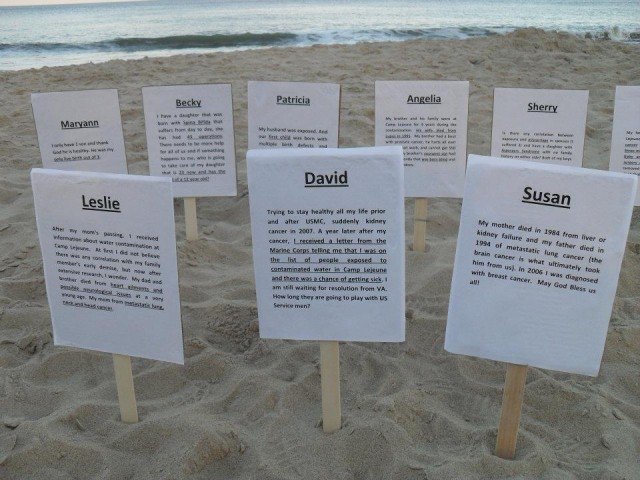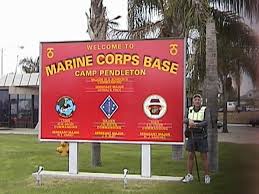by Robert O’Dowd
(SALEM, OR) – The Tampa Bay Times reported on March 10th that ‘the feds’ were reluctant to commit to a cancer incident study of Camp Lejeune veterans. The base wells at Lejeune were contaminated with organic solvents and other toxic chemicals for at least 30 years (1957-1987).
According to William R. Levesque, Tamp Bay Times staff reporter:
Leaders of the federal agency researching the health effects of Camp Lejeune’s polluted water are refusing to say if they will launch a sweeping study that could reveal elevated cancer rates among veterans of the Marine Corps base. They say technical hurdles may prevent such a study. Dr. Vikas Kapil, chief medical officer of the Agency for Toxic Substances and Disease Registry, or ATSDR, told the Tampa Bay Times recently. “And it certainly isn’t an easy thing to do. It cannot be done quickly.”
The results of a mortality study of Camp Lejeune and Camp Pendleton were reported by the federal government in February 2014. In a February 19, 2014, article published in Environmental Health, “Evaluation of mortality among marines and navy personnel exposed to contaminated drinking water at USMC base camp Lejeune: a retrospective cohort study,” reported the results of a retrospective cohort mortality study of Marine and Naval personnel who began service during 1975-1985 and were stationed at Camp Lejeune or Camp Pendleton.
“The purpose of this study was to determine whether exposures of Marine and Naval personnel to contaminated drinking water at Camp Lejeune increased risk of mortality from cancers and other chronic diseases,” according to the study.
The study compared more than 150,000 Marines stationed at Camp Lejeune from 1975 to 1985 to another 150,000 Marines at Camp Pendleton during the same period. The 18,329 deaths from all causes of Marines who were stationed at Camp Lejeune and Camp Pendleton from 1975 until 1985 are a real life horror story and not a laughing matter. The study reported 2,086 cancers from both bases (Camp Lejeune 1,078 and Camp Pendleton All Cancers 1,008). Lejeune Marines had higher cancer death rates than those at Camp Pendleton.
The ATSDR study reported the number of deaths from cancer at both Marine bases were lower than the U.S. population. The study reported that Lejeune Marines had about a 10 percent higher risk of dying from any type of cancer compared to the Pendleton Marines, the study found. They had a 35 percent higher risk of kidney cancer, a 42 percent higher risk of liver cancer, a 47 percent higher risk of Hodgkin lymphoma and a 68 percent higher risk of multiple myeloma. Marines had double the risk of ALS if they’d had a high exposure to vinyl chloride. Both the Camp Pendleton and Camp Lejeune cohorts had a lower cancer mortality rate than the US population.
These were not old men. The median age at the start of the study (1975) was 20 years for both Lejeune and Pendleton. Although the number of deaths from cancers is relatively low (total for both bases of 2,086), the delay between exposures and the onset of disease can take decades.

That’s encouraging but it may be equally important to know the incidence of male breast cancer and other cancers at Lejeune when compared to Pendleton. Cancer survivors were not counted in the ATSDR mortality study. It’s good news that those of us with cancer survived. The incidence of cancer of Marine veterans is important. North Carolina’s Senator Hagan and Senator Richard Burr agree on the need for a cancer incidence study.
U.S. Senator Kay Hagan on February 26, 2014 met with Dr. Tanja Popovic, the Acting Director of ATSDR, along with U.S. Senator Richard Burr and U.S. Representative John Dingell, to discuss water contamination at Camp Lejeune. Hagan questioned Acting Director Popovic about ASTDR’S plan for long-term follow-up to assess the effects of exposures, the need for a cancer incidence study and the progress of reissuing a Public Health Assessment for Camp Lejeune.
The California Congressional delegation has not commented on the need to include Camp Pendleton in any cancer incidence study. Both Marine bases are on the National Priority List (NPL). The NPL is a list maintained by EPA of locations with known releases or threatened releases of hazardous substances, pollutants, or contaminants throughout the United States and its territories.
Early detection and improved cancer treatments are saving more lives. It’s obvious that a higher incidence of cancer of veterans who served at Lejeune or Pendleton is not something that the government would welcome.
Veterans of both Lejeune and Pendleton need to contact their Congressional representatives and ask them to support a cancer incidence study of the two bases. ATSDR needs to compute the cancer incidence rate for both bases before ‘opening the champagne’.
The Defense Department (DOD) may have an ulterior motive for not wanting to fund a cancer incidence study. A cancer incidence study, for example, may show the incidence of cancer at both Lejeune and Pendleton higher than the U.S. population? ‘Join the Marines and get cancer’ is not a good recruiting slogan.
The Agency for Toxic Substances Disease Registry (ATSDR), the federal agency that conducted the Lejeune/Pendleton mortality study, is not an advocate for veterans. ATSDR is not a cabinet level agency. Even well intentioned scientists at ATSDR are no match for power players in DOD. That may explain the reluctance of ATSDR to get involved in a turf battle with DOD.
DOD can easily pressure ATSDR not to do the cancer incidence study. ATSDR can’t do the study without additional funds. ATSDR has to obtain the funding from DOD or from Congress. If DOD and Congress keep the purse shut, then the door to a cancer incidence study is slammed shut.
It wouldn’t be hard for DOD to not pay for the study. DOD can come up with many excuses for ‘better use of appropriated funds’. They can pass the buck to Congress; many of them sympathetic to their friends in the Pentagon. The short answer can easily be, “Sorry, we would like to do this but budgetary constraints and the rising deficit made it impossible to do at this time. We’ll take a hard look at this next year.”
The bottom line is that an ATSDR cancer incidence study can easily die a slow death unless veterans rally around the cause and make a major effort to contact their Congressional representatives to push for the funding of the study.
This is not just a Camp Lejeune fight. Camp Pendleton veterans have a stake in the outcome of an independent cancer incident study, too.
The San Diego Union-Tribune reported in a November 2005 news story, “Toxic woes fester at Camp Pendleton” that “there were more than 500 monitoring wells throughout Camp Pendleton [to] track the movement of contaminants and serve as the front lines for state, federal and Marine Corps agencies working to protect the 60,000 people who live and work on the base.”
It took years for Congress to pass VA health care for Lejeune veterans and dependents and that almost died at the last minute. Fifteen medical conditions were included in the Janey Ensminger Act of 2012. No presumptive VA disability compensation was included in the law. Lejeune veterans have to fight for VA disability compensation. It will be a short fight for those with stage 4 cancer. There was no need for this.
The VA Veterans Law Review in January 2012 posted the legal argument for presumptive disability or Lejeune veterans. It appears that no one in Congress paid much attention to Lin Allison’s legal argument. Allison, a Chapman University Law School graduate and wife of a Marine veteran, documented the case for presumptive disability in no uncertain terms.
The Janey Ensminger Act states that there is no scientific evidence the contaminated wells were not the cause of disease. Beyond belief. This makes no sense at all. Why offer VA health care unless there’s evidence that the contaminated wells (1957 to 1987) were the cause of cancers and other serious diseases?
Camp Lejeune veterans who file for VA disability compensation are winning with medical nexus opinions that support the contamination of the base wells were ‘at least as likely as not’ the cause of their cancers and other diseases.
Could this have anything to do with the thousands of federal tort claims collecting dust in the Navy’s JAG office in Norfolk? You can bet the farm on it. Both veterans and their dependents drank the contaminated water. An estimated 1 million were exposed to the contaminated wells.
If the Janey Ensminger Act stated that the contaminated wells were the least likely cause of disease, this would have opened the door to suits in federal district court and could have cost the government millions in damages to dependents. Like a Lejeune dependent told me several years ago, “It’s all about the green.”

Robert O’Dowd served in the 1st, 3rd and 4th Marine Aircraft Wings during 52 months of active duty in the 1960s. While at MCAS El Toro for two years, O’Dowd worked and slept in a Radium 226 contaminated work space in Hangar 296 in MWSG-37, the most industrialized and contaminated acreage on the base.
Robert is a two time cancer survivor and disabled veteran. Robert graduated from Temple University in 1973 with a bachelor’s of business administration, majoring in accounting, and worked with a number of federal agencies, including the EPA Office of Inspector General and the Defense Logistics Agency.
After retiring from the Department of Defense, he teamed up with Tim King of Salem-News.com to write about the environmental contamination at two Marine Corps bases (MCAS El Toro and MCB Camp Lejeune), the use of El Toro to ship weapons to the Contras and cocaine into the US on CIA proprietary aircraft, and the murder of Marine Colonel James E. Sabow and others who were a threat to blow the whistle on the illegal narcotrafficking activity. O’Dowd and King co-authored BETRAYAL: Toxic Exposure of U.S. Marines, Murder and Government Cover-Up. The book is available as a soft cover copy and eBook from Amazon.com. See: http://www.amazon.com/Betrayal-Exposure-Marines-Government-Cover-Up/dp/1502340003.
ATTENTION READERS
We See The World From All Sides and Want YOU To Be Fully InformedIn fact, intentional disinformation is a disgraceful scourge in media today. So to assuage any possible errant incorrect information posted herein, we strongly encourage you to seek corroboration from other non-VT sources before forming an educated opinion.
About VT - Policies & Disclosures - Comment Policy




